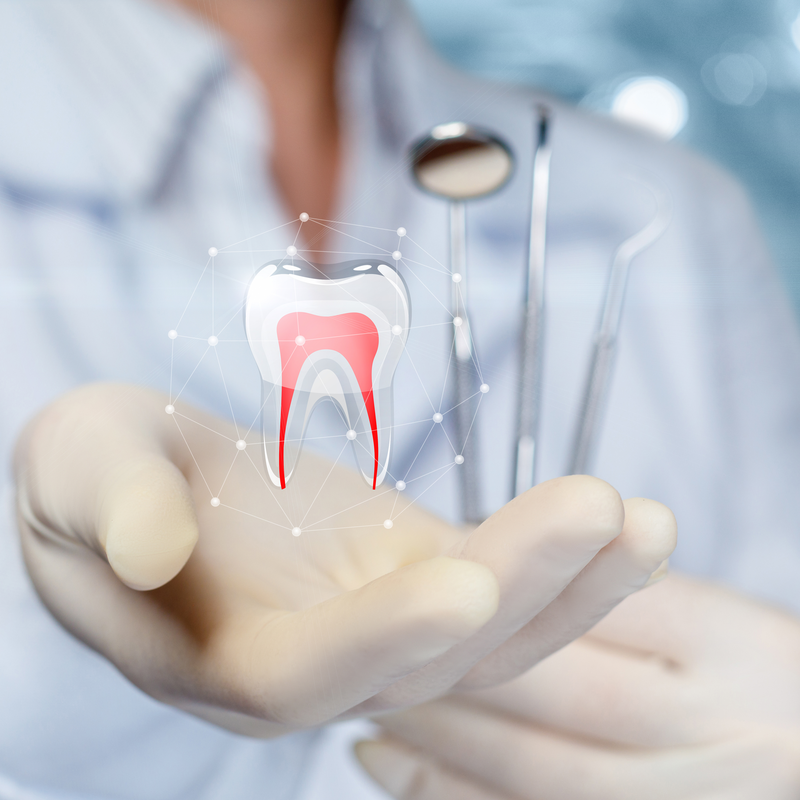
What is a cementoblastoma?
A cementoblastoma is a rare and benign mesenchymal odontogenic tumour. It originates from the cementoblasms, i.e. the cement-forming cells, and is located in precise contact with the tooth root. It grows quite slowly, but can sometimes develop to a considerable size. A cementoblastoma usually occurs between the ages of 20 and 40, and women are statistically more likely to be affected than men. But children can also be affected by cementoblastoma.
What are the symptoms of cementoblastoma?
- mostly one-sided and slow growth,
- Swelling and jaw distension in 70 %,
- Pain in about 61 %,
- Reaction of the teeth always vital,
- in 75 % the localisation is in the mandibular region and posterior region.
How is a cementoblastoma diagnosed?
In most cases, a cementoblastoma is diagnosed by chance during a radiological examination. On the x-ray, a cementoblastoma is usually visible as sharply defined osteolysis with contact to the root tip. If it is in an advanced stage, a radiopaque and homogeneous mass can be seen.
How is a cementoblastoma treated?
Usually a cementoblastoma is discovered in a dental practice. Usually by the fact that tooth eruption is disturbed or the teeth erupt asymmetrically . A radiological examination is then used to determine the location and exact extent of the tooth-like tumour. If a cementoblastoma can be removed promptly, a spontaneous eruption of the teeth is still possible in most cases and damage to the surrounding tissue can be prevented. As a rule, after the complete removal of the blastoma, no more complaints are to be expected , because a cementoblastoma does not tend to recur
If a cementoblastoma is present at , surgical removal is always necessary. This should be done in an oral surgery practice or in a dental clinic. An important factor is that the cementoblastoma with its complete encapsulated tissue area can be removed. Only very rarely is it necessary to remove the surrounding teeth, in which case further orthodontic and surgical measures are required. Thanks to the latest technology in implantology, a restoration of a functional and beautiful looking dentition is possible even in very difficult cases. In the case of an incompletely removed cementoblastoma, recurrences often occur, therefore in most cases a cuirassage is necessary after the removal of the teeth in order to reduce the recurrence rate.
How dangerous is cementoblastoma?
The cementoblastoma is not considered malignant at all. It neither destroys nor infiltrates the surrounding tissue. The cementoblastoma also does not form metastases. However, when it reaches a certain size, the cementoblastoma can displace the neighbouring tissue. Because of this, especially in childhood, the eruption of other teeth can be hindered. This in turn can often lead to the formation of cysts . Cementoblastoma can provide the first signs of another more dangerous disease, because the bowel disease adenomatous polyposis often occurs in conjunction with cementoblastoma. As with pretty much all cancers of the bowel, only early treatment can save lives.
What complications can a cementoblastoma bring?
The main complications and diseases that can be caused by a cementoblastoma are:
- Respiratory system: Impaired nasal breathing,
- Eyes and ocular anatomy: Protrusion of the eyes,
- Mouth, oesophagus, stomach and intestines: Impaired tooth eruption, occlusion disorders, mucosal ulceration,
- Musculoskeletal system and connective tissue: spontaneous bone fractures,
- Neoplasms - tumour diseases: malignant degeneration of a benign neoplasm,
- Psyche-nervous system: paraesthesias
How dangerous is a cementoblastoma in childhood?
Cementoblastoma is the fourth most common type of tumour in the facial and maxillofacial region and can also affect children, even though the average age is about 22.7 years. A cementoblastoma occurs more frequently in the lower jaw, i.e. in the upper jaw. Especially in children an occurrence in the central maxillary region has been identified.
Especially in childhood, a disorder of the tooth eruption can have serious consequences. Likewise, if the position of already existing teeth changes. If the cementoblastoma spreads into the nose or the paranasal sinuses, nasal breathing can be impaired as a result. Only occasionally pain is complained of and in rare cases there is a loss of sensitivity in the area of the alveolar nerve. A malignant degeneration of the cementoblastoma has not yet been described.
Although cementoblastoma usually grows very slowly, the growth in childhood is rapid and is usually reported to last from a few days to three months.
How should a cementoblastoma be followed up?
If a cementoblastoma and the surrounding burdened tissue is completely removed , the prognosis is very good. Only if the cementoblastoma has large lesions and cannot be completely removed is the risk of recurrence high. Since a cementoblastoma is not malignant in any way and therefore does not form metastases, neither chemotherapy nor radiation therapy is advised. Nevertheless, in order to be able to act early if recurrences have formed, a regular clinical examination and, if necessary, imaging with the help of an X-ray is recommended. In children , surgical treatment should be chosen with caution, as severe growth disorders are to be expected in children. It should also be noted that no therapy carried out will have serious consequences of the children's dentition. Due to the frequent tooth eruptions, the risk of malocclusions is extremely high. Therefore, also in childhood, a regular follow-up and examination should be carried out as after-treatment in order to be able to prevent misalignments of the teeth in the case of a new formation of a cementoblastoma .
The follow-up treatment of a cementoblastoma also includes the necessary oral surgery and orthodontic restoration of the dentition if teeth had to be removed as a result of a cementoblastoma .
